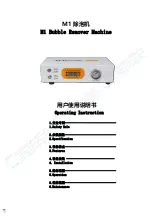
15. Repeat steps
to
.
16. If there is a difference of 40 dB or more between the test ear threshold and nontest ear threshold, the better ear
must be masked to test the poorer ear. The Masking Assistant can assist you in determining which thresholds need to
be masked.
17. To use masking noise in combination with the pure tone, either check
Stim. Lock
to coordinate the presentation of
two channels or check
Continuous On
to keep the masking channel presenting continuously.
18. After the air conduction thresholds are determined, bone conduction audiometry can be performed.
19. Properly place the bone conductor.
20. Instruct the patient again to push the button in response to the tone even if the stimulus is very soft.
21. Make sure that the control panel of the Otosuite software is set to the correct transducer and desired routing, sound
level, and frequency.
22. Repeat steps
to
–
If there is a difference of 10 dB or greater between the bone conduction threshold and the air conduction
threshold of the same ear, masking is needed. The Masking Assistant can assist you in determining which
thresholds need to be masked.
23. When all air and bone conduction thresholds are determined, the pure tone average (PTA) for each will appear in the
PTA/AI
box. The Articulation Index (AI) and the overlay options can be used for counseling the patient.
24. Click in the
Reliability
box to report the reliability of the patient's responses during testing -
Good
,
Fair
, or
Poor
.
5.1.2
Assessing pure tone or speech most comfortable loudness level (MCL)
1. Properly place the earphones.
–
Begin the test with the air conduction transducer.
2. Instruct the patient that you are trying to find the level at which he/she is most comfortable listening to the sounds.
3. Make sure that the control panel of the Otosuite software is set to the correct transducer, desired routing and sound
level.
–
Make sure that most comfortable level test (MCL) is selected.
4. Start at a moderate level. Present the stimulus and ask the patient if the current level is comfortable or if he/she
would prefer it louder or softer.
–
Increase and decrease the sound level until the patient's preferred level is determined. This is the MCL.
–
Once MCL is obtained, store the response.
5. Repeat steps
and
for each frequency if performing MCL testing for pure tones.
6. Switch to the other ear and tell the patient to listen for the sounds in that ear.
7. Repeat steps
and
for the opposite ear.
5.1.3
Assessing pure tone or speech uncomfortable loudness level (UCL)
1. Properly place the earphones.
–
Begin the test with the air conduction transducer.
2. Instruct the patient that you are trying to find the level at which the sound is uncomfortably loud. It should be tol-
erable and not painful.
64
Madsen A450
5 Examples of audiometric testing
















































